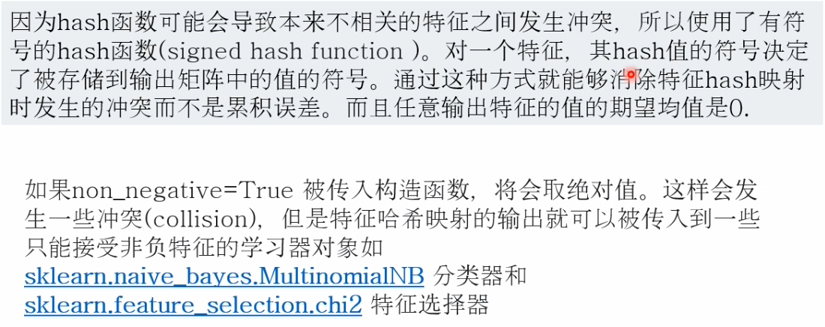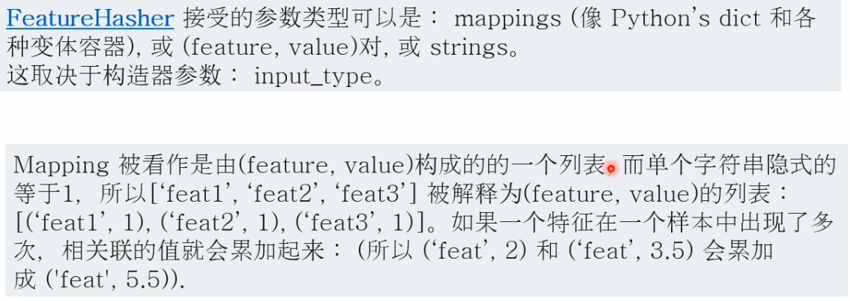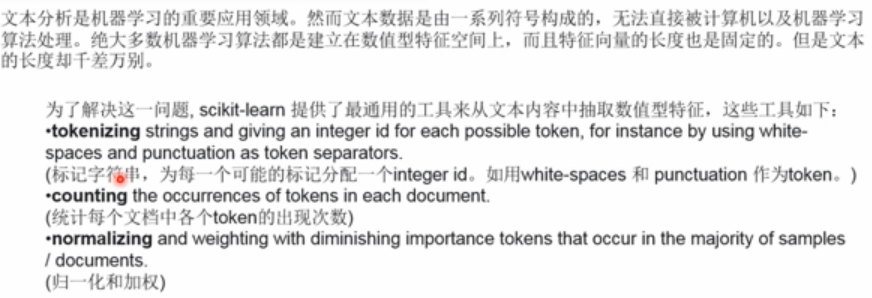sklearn特征抽取
特征抽取sklearn.feature_extraction 模块提供了从原始数据如文本,图像等众抽取能够被机器学习算法直接处理的特征向量。

1.特征抽取方法之 Loading Features from Dicts


measurements=[ {'city':'Dubai','temperature':33.}, {'city':'London','temperature':12.}, {'city':'San Fransisco','temperature':18.}, ] from sklearn.feature_extraction import DictVectorizer vec=DictVectorizer() print(vec.fit_transform(measurements).toarray()) print(vec.get_feature_names()) #[[ 1. 0. 0. 33.] #[ 0. 1. 0. 12.] #[ 0. 0. 1. 18.]] #['city=Dubai', 'city=London', 'city=San Fransisco', 'temperature']
2.特征抽取方法之 Features hashing




3.特征抽取方法之 Text Feature Extraction
词袋模型 the bag of words represenatation



#词袋模型 from sklearn.feature_extraction.text import CountVectorizer #查看默认的参数 vectorizer=CountVectorizer(min_df=1) print(vectorizer) """ CountVectorizer(analyzer='word', binary=False, decode_error='strict', dtype=<class 'numpy.int64'>, encoding='utf-8', input='content', lowercase=True, max_df=1.0, max_features=None, min_df=1, ngram_range=(1, 1), preprocessor=None, stop_words=None, strip_accents=None, token_pattern='(?u)\\b\\w\\w+\\b', tokenizer=None, vocabulary=None) """ corpus=["this is the first document.", "this is the second second document.", "and the third one.", "Is this the first document?"] x=vectorizer.fit_transform(corpus) print(x) """ (0, 1) 1 (0, 2) 1 (0, 6) 1 (0, 3) 1 (0, 8) 1 (1, 5) 2 (1, 1) 1 (1, 6) 1 (1, 3) 1 (1, 8) 1 (2, 4) 1 (2, 7) 1 (2, 0) 1 (2, 6) 1 (3, 1) 1 (3, 2) 1 (3, 6) 1 (3, 3) 1 (3, 8) 1 """
默认是可以识别的字符串至少为2个字符
analyze=vectorizer.build_analyzer() print(analyze("this is a document to anzlyze.")==
(["this","is","document","to","anzlyze"])) #True
在fit阶段被analyser发现的每一个词语都会被分配一个独特的整形索引,该索引对应于特征向量矩阵中的一列
print(vectorizer.get_feature_names()==( ["and","document","first","is","one","second","the","third","this"] )) #True print(x.toarray()) """ [[0 1 1 1 0 0 1 0 1] [0 1 0 1 0 2 1 0 1] [1 0 0 0 1 0 1 1 0] [0 1 1 1 0 0 1 0 1]] """
获取属性
print(vectorizer.vocabulary_.get('document')) #1
对于一些没有出现过的字或者字符,则会显示为0
vectorizer.transform(["somthing completely new."]).toarray() """ [[0 1 1 1 0 0 1 0 1] [0 1 0 1 0 2 1 0 1] [1 0 0 0 1 0 1 1 0] [0 1 1 1 0 0 1 0 1]] """
在上边的语料库中,第一个和最后一个单词是一模一样的,只是顺序不一样,他们会被编码成相同的特征向量,所以词袋表示法会丢失了单词顺序的前后相关性信息,为了保持某些局部的顺序性,可以抽取2个词和一个词
bigram_vectorizer=CountVectorizer(ngram_range=(1,2),token_pattern=r"\b\w+\b",min_df=1) analyze=bigram_vectorizer.build_analyzer() print(analyze("Bi-grams are cool!")==(['Bi','grams','are','cool','Bi grams', 'grams are','are cool'])) #True x_2=bigram_vectorizer.fit_transform(corpus).toarray() print(x_2) """ [[0 0 1 1 1 1 1 0 0 0 0 0 1 1 0 0 0 0 1 1 0] [0 0 1 0 0 1 1 0 0 2 1 1 1 0 1 0 0 0 1 1 0] [1 1 0 0 0 0 0 0 1 0 0 0 1 0 0 1 1 1 0 0 0] [0 0 1 1 1 1 0 1 0 0 0 0 1 1 0 0 0 0 1 0 1]] """




【推荐】还在用 ECharts 开发大屏?试试这款永久免费的开源 BI 工具!
【推荐】国内首个AI IDE,深度理解中文开发场景,立即下载体验Trae
【推荐】编程新体验,更懂你的AI,立即体验豆包MarsCode编程助手
【推荐】轻量又高性能的 SSH 工具 IShell:AI 加持,快人一步